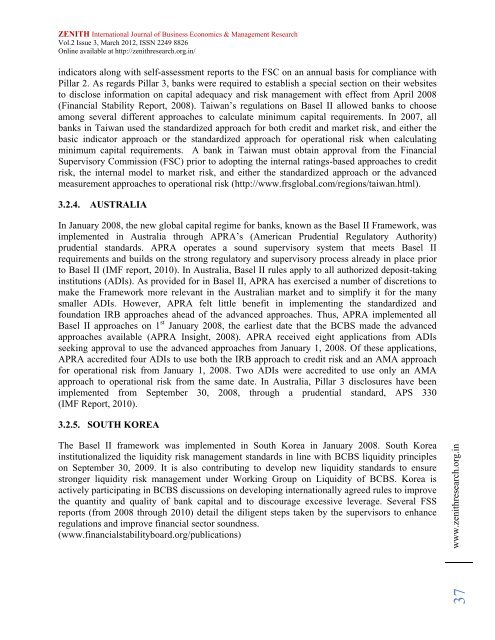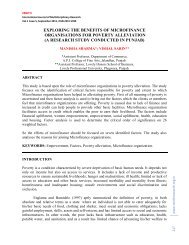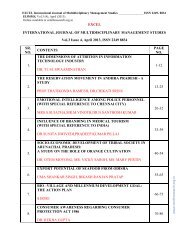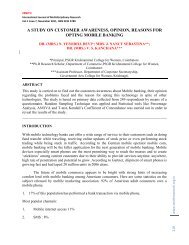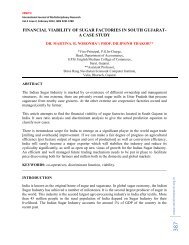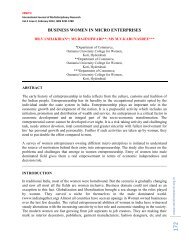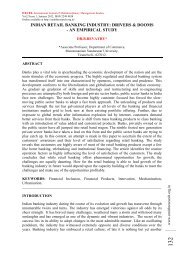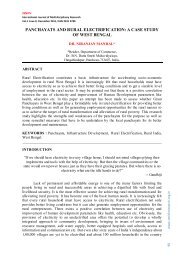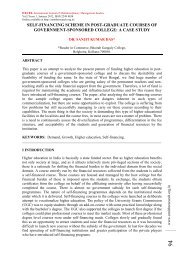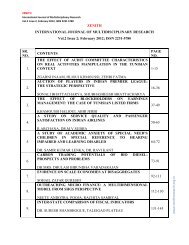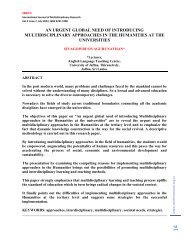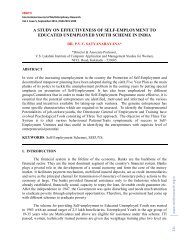ZIJBEMR MARCH 2012 ISSUE COMPLETE.pdf - zenith ...
ZIJBEMR MARCH 2012 ISSUE COMPLETE.pdf - zenith ...
ZIJBEMR MARCH 2012 ISSUE COMPLETE.pdf - zenith ...
You also want an ePaper? Increase the reach of your titles
YUMPU automatically turns print PDFs into web optimized ePapers that Google loves.
37www.<strong>zenith</strong>research.org.inZENITH International Journal of Business Economics & Management ResearchVol.2 Issue 3, March <strong>2012</strong>, ISSN 2249 8826Online available at http://<strong>zenith</strong>research.org.in/indicators along with self-assessment reports to the FSC on an annual basis for compliance withPillar 2. As regards Pillar 3, banks were required to establish a special section on their websitesto disclose information on capital adequacy and risk management with effect from April 2008(Financial Stability Report, 2008). Taiwan’s regulations on Basel II allowed banks to chooseamong several different approaches to calculate minimum capital requirements. In 2007, allbanks in Taiwan used the standardized approach for both credit and market risk, and either thebasic indicator approach or the standardized approach for operational risk when calculatingminimum capital requirements. A bank in Taiwan must obtain approval from the FinancialSupervisory Commission (FSC) prior to adopting the internal ratings-based approaches to creditrisk, the internal model to market risk, and either the standardized approach or the advancedmeasurement approaches to operational risk (http://www.frsglobal.com/regions/taiwan.html).3.2.4. AUSTRALIAIn January 2008, the new global capital regime for banks, known as the Basel II Framework, wasimplemented in Australia through APRA’s (American Prudential Regulatory Authority)prudential standards. APRA operates a sound supervisory system that meets Basel IIrequirements and builds on the strong regulatory and supervisory process already in place priorto Basel II (IMF report, 2010). In Australia, Basel II rules apply to all authorized deposit-takinginstitutions (ADIs). As provided for in Basel II, APRA has exercised a number of discretions tomake the Framework more relevant in the Australian market and to simplify it for the manysmaller ADIs. However, APRA felt little benefit in implementing the standardized andfoundation IRB approaches ahead of the advanced approaches. Thus, APRA implemented allBasel II approaches on 1 st January 2008, the earliest date that the BCBS made the advancedapproaches available (APRA Insight, 2008). APRA received eight applications from ADIsseeking approval to use the advanced approaches from January 1, 2008. Of these applications,APRA accredited four ADIs to use both the IRB approach to credit risk and an AMA approachfor operational risk from January 1, 2008. Two ADIs were accredited to use only an AMAapproach to operational risk from the same date. In Australia, Pillar 3 disclosures have beenimplemented from September 30, 2008, through a prudential standard, APS 330(IMF Report, 2010).3.2.5. SOUTH KOREAThe Basel II framework was implemented in South Korea in January 2008. South Koreainstitutionalized the liquidity risk management standards in line with BCBS liquidity principleson September 30, 2009. It is also contributing to develop new liquidity standards to ensurestronger liquidity risk management under Working Group on Liquidity of BCBS. Korea isactively participating in BCBS discussions on developing internationally agreed rules to improvethe quantity and quality of bank capital and to discourage excessive leverage. Several FSSreports (from 2008 through 2010) detail the diligent steps taken by the supervisors to enhanceregulations and improve financial sector soundness.(www.financialstabilityboard.org/publications)


